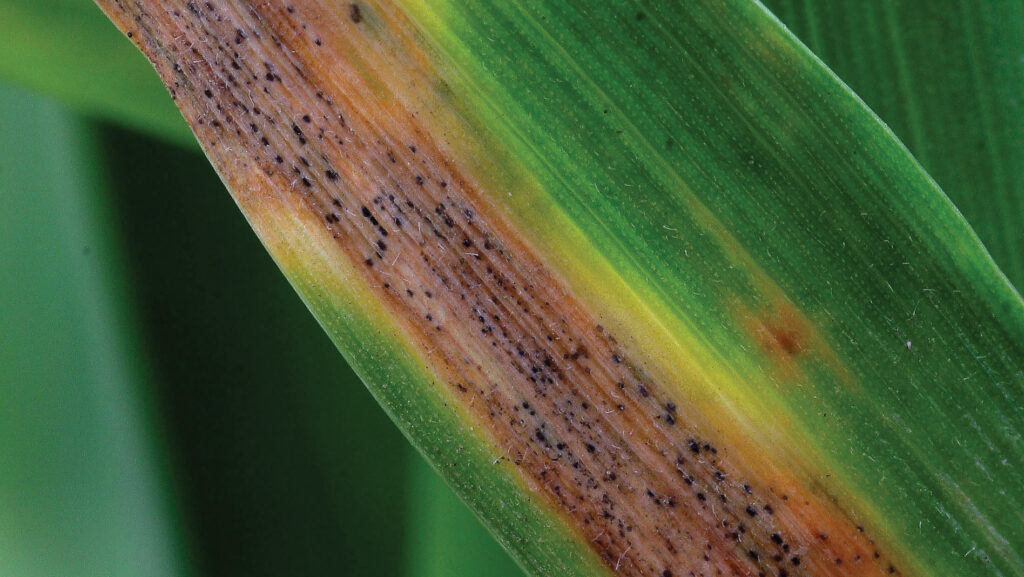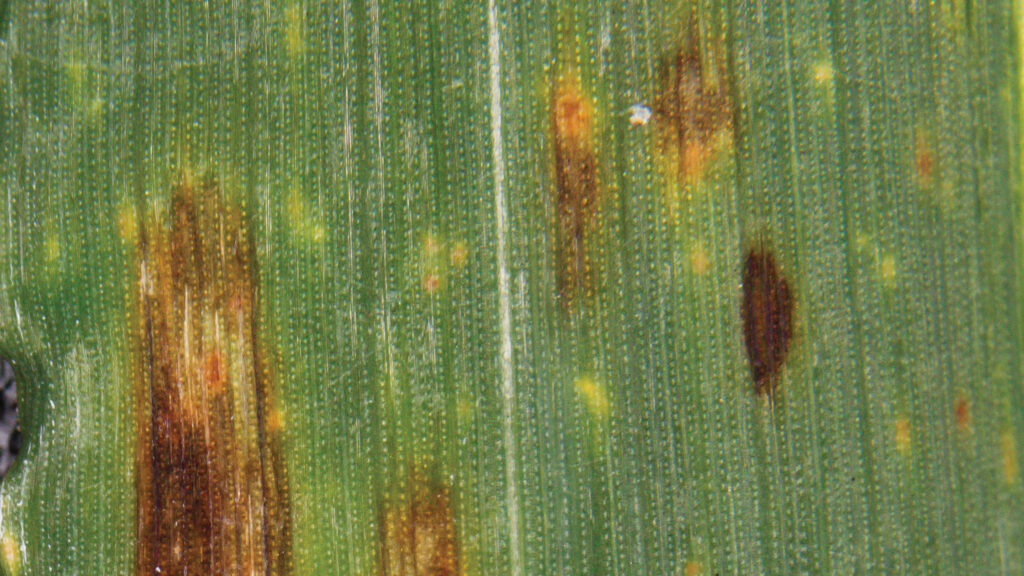How farmers will benefit from new SDHI wheat fungicide at T2
 © Tim Scrivener
© Tim Scrivener Winter wheat growers will see a step up in the control of septoria, the crop’s number one disease, at the T2 timing this spring, with a new broad-spectrum fungicide offering higher yields.
It is the first SDHI fungicide to offer control of fusarium head blight and it also brings barley growers industry-leading efficacy against ramularia and net blotch, plus good control of rhynchsporium.
The new SDHI active pydiflumetofen, also known as Adepidyn, comes from Syngenta and will be marketed in Britain as Miravis Plus and available in a co-pack with the widely used azole prothioconazole.
See also: Greater yield and margin for winter barley grower
Syngenta says the new SDHI is structurally different from other SDHIs, giving it greater potency and making it longer lasting (see panel).
It will compete with other T2 wheat fungicides such as Revystar and Univoq. And although this is the first full season for fellow newcomer Vimoy, Bayer has aimed it at the T1 timing.
All agronomists who spoke to Farmers Weekly agreed that Miravis Plus is a welcome addition, bringing levels of control not seen in existing products for some key diseases, but they said it would also need to stand up financially.
It’s also good news for ramularia control in barley, as the loss of chlorothalonil in 2020 has left a big gap in fungicide firepower for this disease.
So what does it mean for farmers this season? Adas pathologist Jonathan Blake says that following weeks of relentless wet weather, there is a significant disease threat in cereal crops in many parts of the country.
“I think choosing the best available chemicals at T2 will be something anybody with a decent crop of wheat should be considering,” he says.
Farmer Weekly takes a closer look.

Septoria on winter wheat @ Blackthorn Arable
Wheat
In wheat, Miravis Plus excels at septoria control. AHDB trials show the SDHI is highly active in both protectant and eradicant situations, performing as well or better than existing standards when applied at or above a half-label rate. These results have been consistent over the trial years (since 2019).
Single-spray average yield responses over the past three years showed a 0.4t/ha yield advantage over Peqtiga, the next most effective solo active, when compared at a full-label dose, says AHDB.
Syngenta points to its own trials carried out in more commercial conditions within multi-spray programmes, with 244 comparisons over 2020-2023.
Jason Tatnell, cereal fungicide technical manager at Syngenta, says they saw 0.3t/ha extra yield above the next-best Univoq and 0.5t/ha over Revystar.
In conclusion, Syngenta says there is a strong justification to use the fungicide in a high pressure year such as this, with plenty of disease and wet weather.
Agronomist reaction
While agronomists welcome the fungicide, they point to the economic considerations in what is a challenging season, with farmers having to target their spend.
Jock Willmott, independent agronomist and partner at Ceres Rural, says he will be using Miravis Plus at T2 this season “in higher value wheat crops” if septoria pressure remains high, to get “the greatest yield response”.
In Yorkshire, Niab regional agronomist Patrick Stephenson says from what he has seen in trials, it is a very good product.
“Its septoria control is a level above other products in the market.”
Patrick expects some of his growers to use it this year and compare it with their current fungicide. “An 0.5t/ha uplift in yield will encourage farmers to use more of it, 0.1 or 0.2t/ha will not,” he says.
However, in heavy rust situations, he says he would use different products.
AHDB trial data shows that other SDHIs, such as Vimoy, Elatus Plus, or Imtrex, are more active against brown rust than Miravis Plus.

Ramularia leaf spot on barley leaves © Blackthorn Arable
Barley
For barley, SRUC cereal disease specialist Fiona Burnett confirms good results against three key diseases – ramularia, rhynchosporium and net blotch.
Growers have for several years grappled with ramularia, due to the loss of chlorothalonil and the disease gaining resistance.
In the AHDB trials, Miravis Plus consistently showed much stronger control over three seasons when compared to the previously leading product, Myresa, which was itself more effective than the other long-established standard prothioconazole.
Against rhynchosporium, the fungicide has consistently performed as well as or better than existing standards, such as prothioconazole, Imtrex, Ascra Xpro and Myresa.
On average, Miravis Plus increased yield by 0.3 t/ha (over the past three years) compared with Imtrex, the next most effective solo active, when compared at a half-label dose.
Against net blotch, Miravis Plus gave consistently better control than the existing azole-based standards (listed above). It was also notably better than the other straight SDHI in the trial, Imtrex.
Syngenta says in its own trials, it saw a 0.5t/ha yield benefit over Revystar.
Expert reaction
Fiona says it’s good to have something new, given that barley growers have been losing products, including some to resistance.
She says for ramularia, it shows “very good activity and yield benefit”.
“There is also good activity on net blotch and rhyncosporium, where we are struggling with resistance to other products.”
She says in SRUC trials it gave a 0.4t/ha boost to barley yields and in a ramularia scenario, it was more like 0.5t/ha.
Therefore, she sees the new fungicide having a role in more challenging scenarios in good crops with potential.
She says there is quite a bit of rhyncosporium in winter barley crops and is planning to try some at the T2.
Longer-lasting control
A key feature highlighted by Syngenta research is the SDHI’s greater persistency in the flag leaf, offering longer lasting control.
Speaking at the product launch, Syngenta’s Jason Tatnell says plants growing in a glasshouse were treated on leaf two (with the flag leaf not emerged).
Tissue was sampled at the T2 and then the T3 timings. As with other fungicides on the market, the molecule had moved to the tip of the flag leaf for the T2 timing.
Interestingly, a month after application, levels of pydiflumetofen had increased further, while the other products had declined.
Jason says it shows how long lasting the molecule is within the plant.
This is important to farmers as every day the green leaf area index is above 37%, it adds 0.15t/ha to yield.
“We are seeing greener plants and this is leading to greater yields,” he says.
Fusarium
Pydiflumetofen is the first SDHI fungicide to show activity against fusarium and while Syngenta is not targeting the T3 timing, research shows benefits from a T2 spray (see panel).
AHDB inoculation trials indicate that it has excellent activity when compared with the azole standard Proline.
However, while T3 is the best timing for managing fusarium, Syngenta advocates its use at the T2 timing to maximise the benefits on the foliar diseases.
Syngenta’s Jason Tatnell points to trials carried out by Professor Simon Edwards at Harper Adams University College in 2022 showing reduced fusarium risk with a T2 application.
Comparing Miravis Plus with Revystar and Univoq, there was no improvement in levels of the mycotoxin deoxynivalenol (DON) with Revystar.
Univoq saw a reduction due to the prothioconazole component and Miravis Plus + Era took levels even lower, close to the DON limit of 1,250ppb.
“Adding prothioconazole at T3 then completed the job,” he says, with levels below the legal limit.
So when targeting foliar disease at T2, farmers also get the bonus of some fusarium control. “It offers insurance at T3 in case you don’t get the timing right.”
Actives
- Ascra Xpro – bixafen + fluopyram + prothioconazole
- Elatus Plus – benzovindiflupyr
- Era/Proline – prothioconazole
- Imtrex – fluxapyroxad
- Miravis Plus – pydiflumetofen (Adepidyn)
- Myresa – mefentrifluconazole
- Peqtiga – fenpicoxamid
- Revystar – fluxapyroxad + mefentrifluconazole
- Univoq – fenpicoxamid + prothioconazole
- Vimoy – isoflucypram (Iblon)

